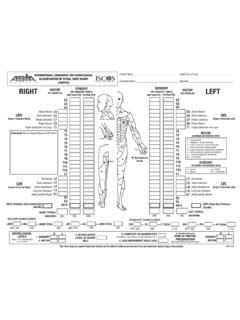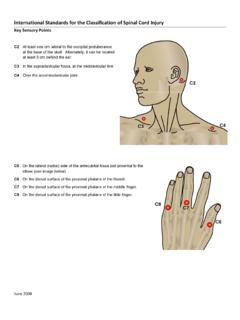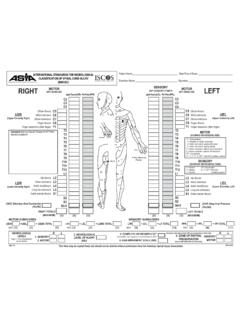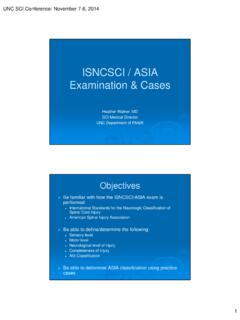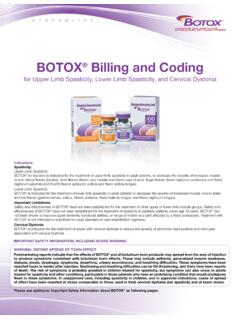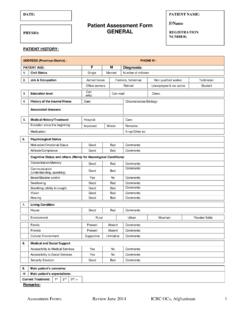Transcription of International Standards for the Classification of Spinal ...
1 February 2020 page 1 International Standards for the Classification of Spinal Cord Injury Motor Exam Guide C5 Elbow Flexors | Biceps Brachii, Brachialis Grade 3 Patient Position: The shoulder is in neutral rotation, neutral flexion/extension, and neutral ab/adduction. The elbow is fully extended, with the forearm in full supination. The wrist is in neutral flexion/extension. Examiner Position: Support the wrist. Instructions to Patient: Bend your elbow and try to reach your hand to your nose. Action: The patient attempts to move through the full range of motion in elbow flexion. Grades 4 & 5 Patient Position: The shoulder is in neutral rotation, neutral flexion/extension, and neutral ab/adduction. The elbow is flexed to 90 and the forearm is fully supinated. Examiner Position: Place a stabilizing hand on the anterior shoulder. Grasp the volar aspect of the wrist and exert a pulling force in the direction of elbow extension.
2 Instructions to Patient: Hold your arm. Don t let me move it. Action: The patient resists the examiner s pull and attempts to maintain the elbow flexed at 90 . Grade 2 Patient Position: The shoulder is in internal rotation and adducted with the forearm positioned above the abdomen, just below the umbilicus. The elbow is in 30 of flexion. The forearm and wrist are in neutral pronation/supination. Sufficient flexion of the shoulder must be permitted to allow the forearm to comfortably move over the abdomen. Examiner Position: Support the arm. Instructions to Patient: Bend your elbow and try to bring your hand to your nose. Action: The patient attempts to move the elbow through a full range of motion in elbow flexion. International Standards for the Classification of Spinal Cord Injury Motor Exam Guide February 2020 page 2 Grades 0 & 1 Patient: The patient is in the Grade 2 position with the shoulder in internal rotation and adducted.
3 The palm and ventral forearm are positioned above the abdomen. The elbow is in 30 of flexion. The forearm and wrist are in neutral pronation/supination. Sufficient flexion of the shoulder must be permitted to allow the forearm to comfortably move over the abdomen. Examiner Position: One hand supports the forearm while the other hand palpates the biceps tendon in the cubital fossa. The belly of the biceps brachii muscle may also be palpated or observed for movement. Instructions to Patient: Bend your elbow and try to bring your hand to your nose. Action: The patient attempts to move the elbow through a full range of motion in elbow flexion. C6 Wrist Extensors | Extensor Carpi Radialis Longus, Extensor Carpi Radialis Brevis Grade 3 Patient Position: The shoulder is in neutral rotation, neutral flexion/extension, and neutral ab/adduction.
4 The elbow is fully extended, the forearm is fully pronated, and the wrist flexed. Examiner Position: One hand supports the distal forearm to allow the wrist to be pre-positioned in sufficient flexion for testing. Instructions to Patient: Bend your wrist upwards. Lift your fingers toward the ceiling. Action: The patient attempts to extend the wrist through a full range of motion. International Standards for the Classification of Spinal Cord Injury Motor Exam Guide February 2020 page 3 Grades 4 & 5 Patient Position: Same as Grade 3, except the wrist is fully extended. Examiner Position: Grasp the distal forearm to stabilize the wrist. Apply pressure across the metacarpals in a downward direction toward flexion and ulnar deviation. The force applied should be angled toward the ulnar side of the wrist rather than directly downward, since it is the radial wrist extensors that are being tested.
5 Instructions to Patient: Hold your wrist up. Don t let me push it down. Action: The patient resists the examiner s push and attempts to maintain the wrist in the fully extended position. Grades 0, 1 & 2 Patient Position: Position the patient with the arm resting on the exam table. The shoulder is in neutral flexion/extension, neutral rotation, and neutral ab/adduction. The elbow is fully extended. The forearm is in neutral pronation-supination and the wrist fully flexed As per the picture, the patient may also be positioned with the shoulder in slight flexion, internal rotation, and abducted, with the patient s arm above the abdomen. The elbow is flexed to 90 and the forearm is in full supination. The wrist is flexed. Examiner Position: Support the forearm and ask the patient to bend the wrist backwards into extension. For trace function, palpate the radial wrist extensors just proximal to the wrist, on the radial aspect of the distal forearm.
6 Observe the muscle belly for movement. Instructions to Patient: Bend your wrist backwards. Action: The patient attempts to extend the wrist though a full range of motion in wrist extension. C6 Common Muscle Substitution Wrist extension can be mimicked by forearm supination and the use of gravity. The examiner needs to make sure the forearm is stabilized and is in proper position. International Standards for the Classification of Spinal Cord Injury Motor Exam Guide February 2020 page 4 C7 Elbow Extensors | Triceps Grade 3 Patient Position: The shoulder is in neutral rotation, neutral ab/adduction, and 90 of flexion. The elbow is fully flexed with the palm of the hand resting by the ear. Examiner Position: Support the upper arm. Instructions to Patient: Straighten your arm. Action: The patient attempts to move through the full range of elbow extension. Grades 4 & 5 Patient Position: Same as Grade 3, except the elbow is in 45 of flexion.
7 Examiner Position: Support the upper arm. Grasp the wrist and apply resistance to the distal forearm in the direction of elbow flexion. Instructions to Patient: Hold this position. Don t let me bend your elbow. Action: The patient resists the examiner s pressure and attempts to maintain the position of the elbow in 45 of flexion. Grade 2 Patient Position: Support the patient s arm under the elbow and the wrist. The shoulder is in internal rotation, with the forearm positioned above the abdomen. The forearm is in neutral pronation/supination. The elbow is fully flexed. When checking Grade 2, sufficient flexion of the shoulder must be permitted to allow the forearm to clear and move over the chest and abdomen. Examiner Position: Support the patient s arm under the elbow and wrist. Instructions to Patient: Straighten your arm. Action: The patient attempts to move through the full range of elbow extension.
8 International Standards for the Classification of Spinal Cord Injury Motor Exam Guide February 2020 page 5 Grades 0 & 1 Patient Position: Maintain the Grade 2 position with the shoulder in internal rotation, and the forearm positioned above the abdomen. The forearm is in neutral pronation/supination and the elbow is in 30 of flexion. Examiner Position: Support the arm. For trace function, palpate the distal triceps at its insertion on the olecranon. The belly of the triceps muscle may also be palpated and observed for movement. Instructions to Patient: Straighten your arm. Action: The patient attempts to fully extend the elbow. C7 Common Muscle Substitution Elbow extension can be mimicked by externally rotating the shoulder, by quickly flexing the elbow and then relaxing, and with spasticity of the triceps. These substitutions can be minimized by maintaining the correct position for testing, correct instructions to the patient, and avoiding elbow flexion.
9 Palpation of the triceps should be done to confirm the patient is using the correct muscle for the test. C8 Long finger flexors | flexor Digitorum Profundus Grade 3 Patient Position: The shoulder is in neutral rotation, neutral flexion-extension, and neutral ab/adduction. The elbow is fully extended with the forearm fully supinated. The wrist is in neutral flexion-extension. The metacarpal phalangeal (MCP) and proximal interphalangeal joints (PIP) are stabilized in extension. Examiner Position: Using two hands grasp the patient s hand and stabilize the wrist in neutral. Secure the PIP and MCP joints in extension with both hands while isolating the middle finger for testing. Stabilize the volar aspect of the 3rd middle phalanx with the thumb of the opposite hand. As an alternate method, one hand may be used to stabilize instead of two, with the patient s hand fully supinated on the bed/mat.
10 The PIP and MCP joints are stabilized as previously described and securing the middle phalanx, and the examiner assuring wrist tenodesis is avoided with forearm stabilization. Instructions to Patient: Bend the tip of your middle finger. Action: The patient attempts to flex the distal interphalangeal (DIP) joint through the full range of motion in flexion. International Standards for the Classification of Spinal Cord Injury Motor Exam Guide February 2020 page 6 Grades 4 & 5 Patient Position: The same as Grade 3, except the DIP joint is fully flexed. Examiner Position: Stabilize the wrist, MCP and PIP joints as in Grade 3. Apply pressure with the tip of the finger or thumb against the distal phalanx of the patient s middle finger. Instructions to Patient: Hold the tip of your finger in this bent position. Don t let me move it. Action: The patient attempts to maintain the fully flexed position of the DIP joint, and resist the pressure applied by the examiner in the direction of finger extension.
